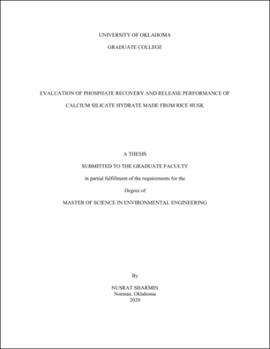| dc.description.abstract | In this study, calcium silicate hydrate was synthesized using silica-rich rice husk for recovering phosphorus from wastewater and reusing it as fertilizer under simulated soil conditions. By controlling pH and inhibiting calcite formation during synthesis, a non-crystalline form of calcium silicate hydrate was produced which showed significantly higher phosphate uptake capacity. The driving force for phosphate uptake by calcium silicate hydrate was identified as the presence of sufficient amount of Ca2+ and PO43- ions to cause supersaturation and precipitation of calcium phosphate. Calcium silicate hydrate was able to uptake 99% of the total phosphate from solutions of deionized water (for initial concentration of 68.5 mg P/L, equilibrium pH 9). The removal capacity of calcium silicate hydrate was substantially decreased in a high alkalinity system (4936 mg/L as CaCO3), modeling the concentrations of anaerobic treatment effluent of dairy manure, due to the formation of calcite instead of calcium phosphate. By gradually decreasing the alkalinity, a proportionate increase in phosphate uptake was observed, and model wastewaters with alkalinity levels of 100, 200 and 300 mg/L as CaCO3 showed similar phosphate uptake (≥99%) as deionized water (without any alkalinity). Phosphorus was extracted from spent calcium silicate hydrate by modified methods of soil phosphorus tests, i.e., Mehlich 3, Bray P1 and Olsen simulating conditions of neutral, acidic, and alkaline soil, respectively. The precipitated solids in deionized water released a relatively lower amount of phosphorus in Mehlich 3 extractant, which only measures the adsorbed form of phosphorus. This suggested that most of the phosphorus in deionized water solutions was removed by precipitation of a phosphate mineral and not by adsorption. Olsen test performed poorly to estimate the released phosphorus from solids collected from the high alkalinity wastewater, because of the increased concentration of HCO3- prevailing in the system. | en_US |
